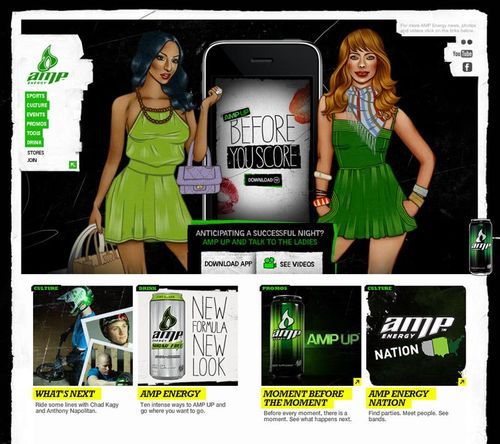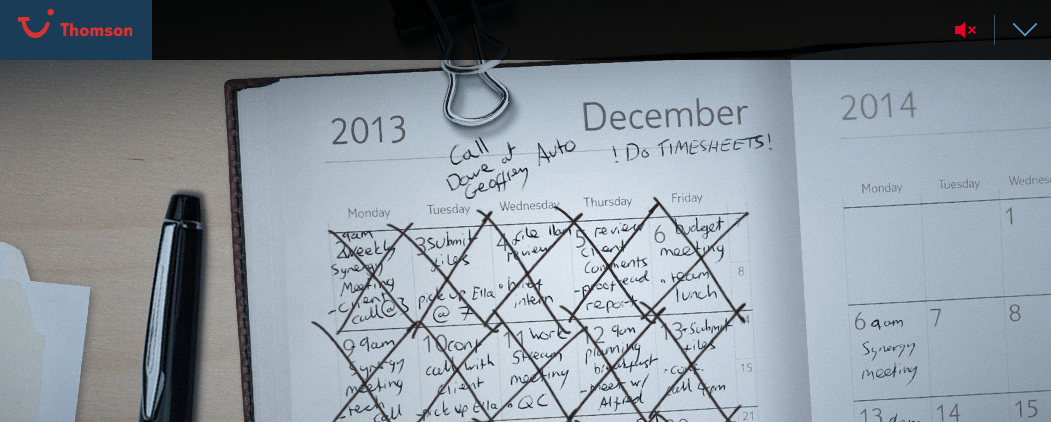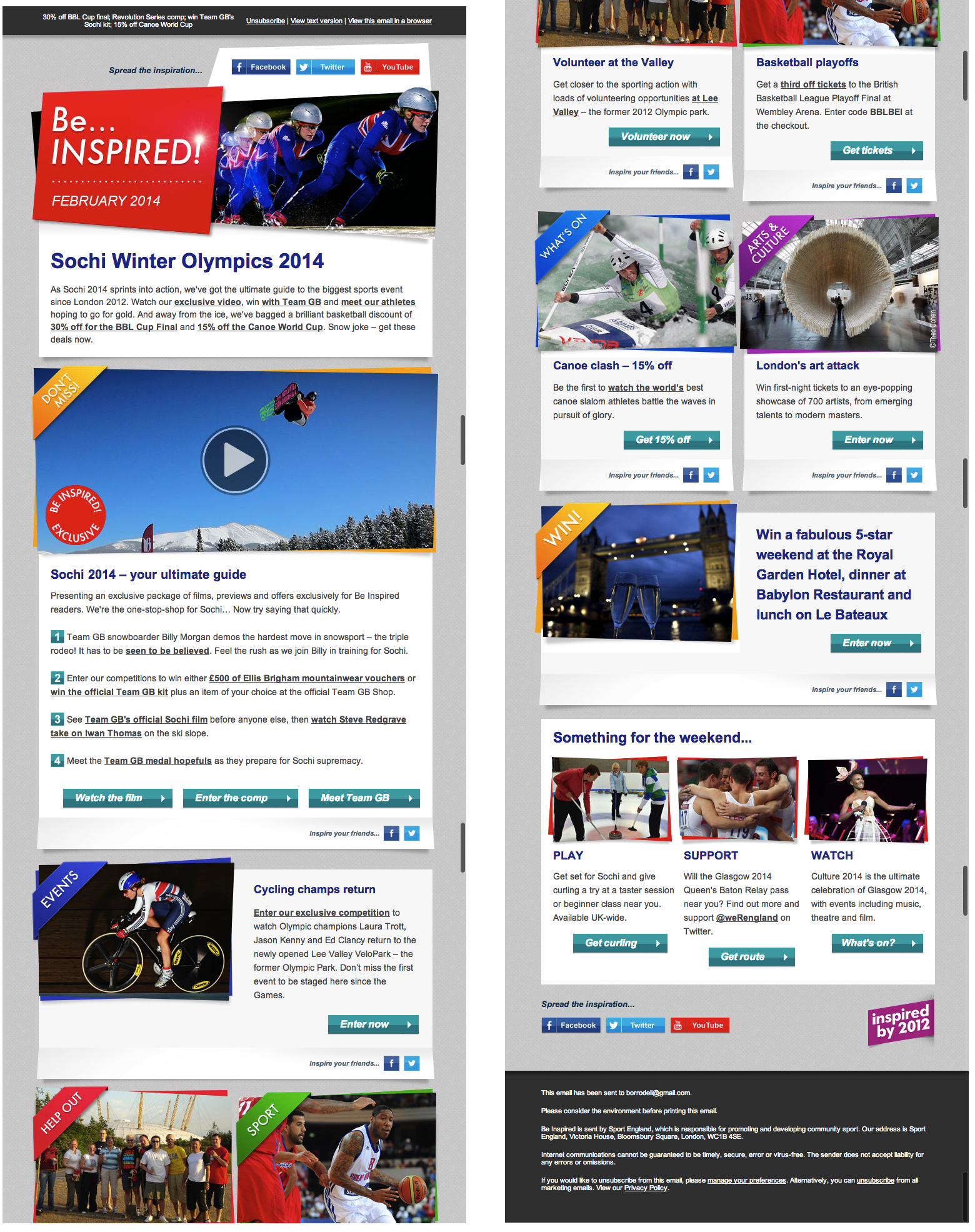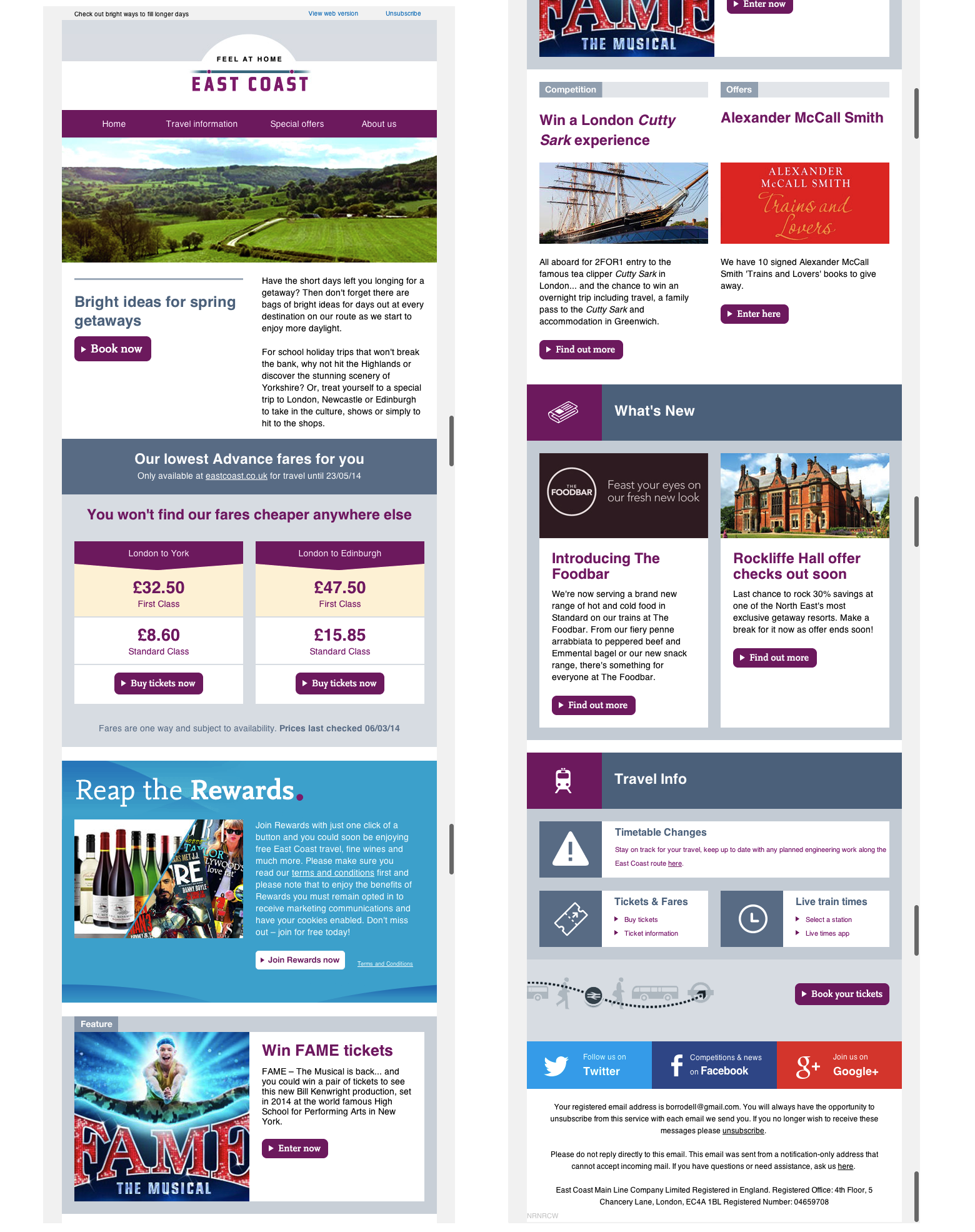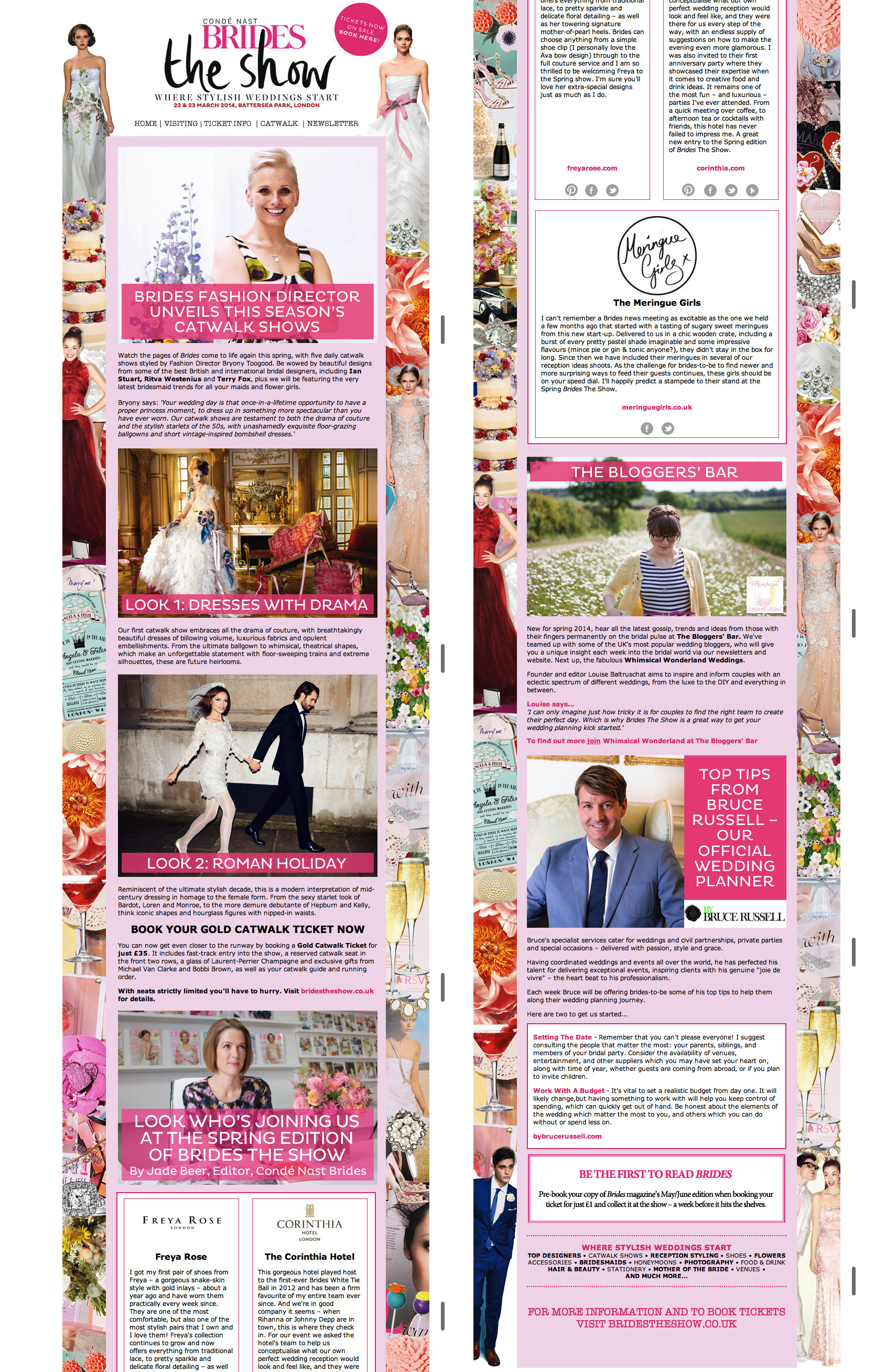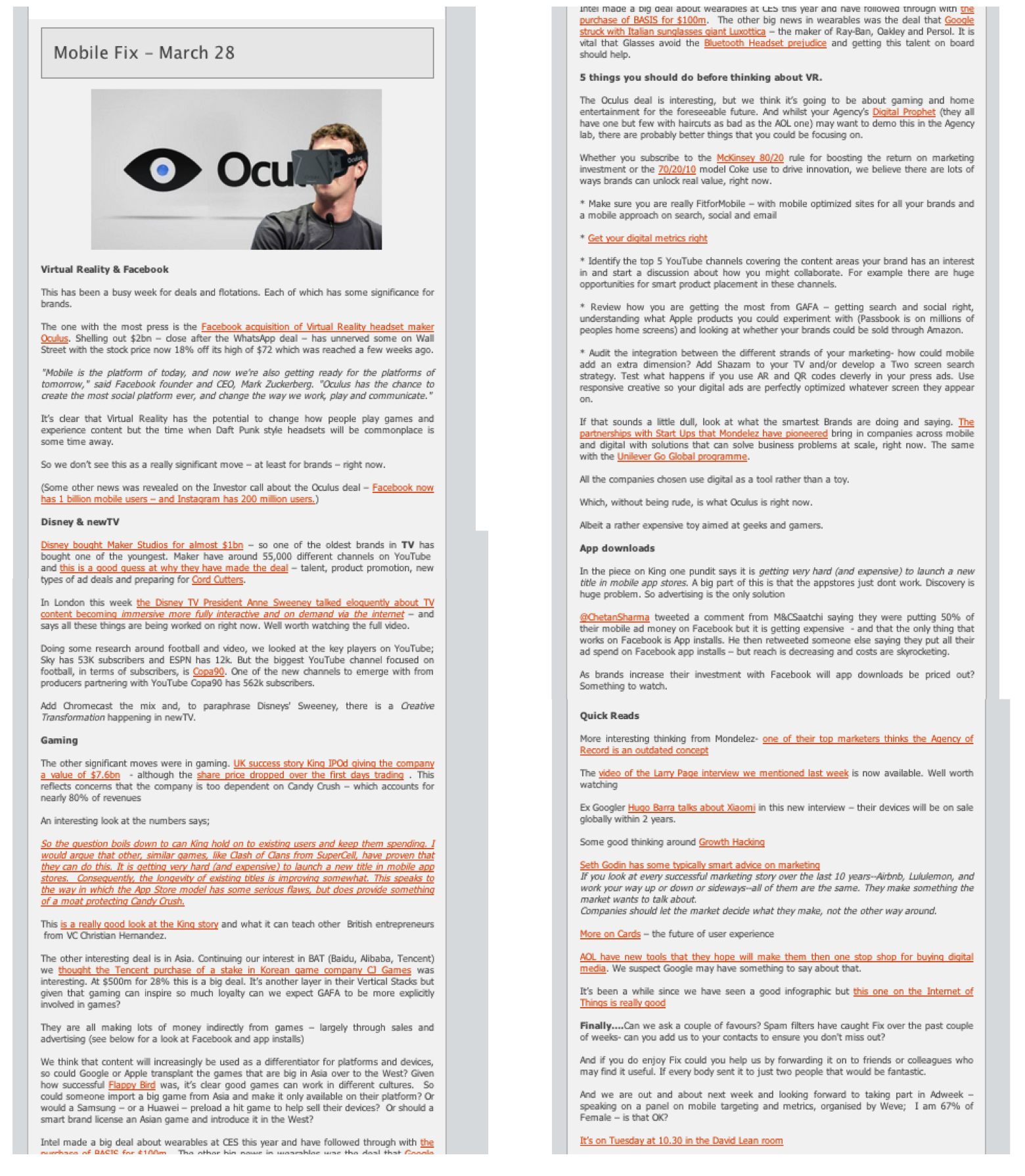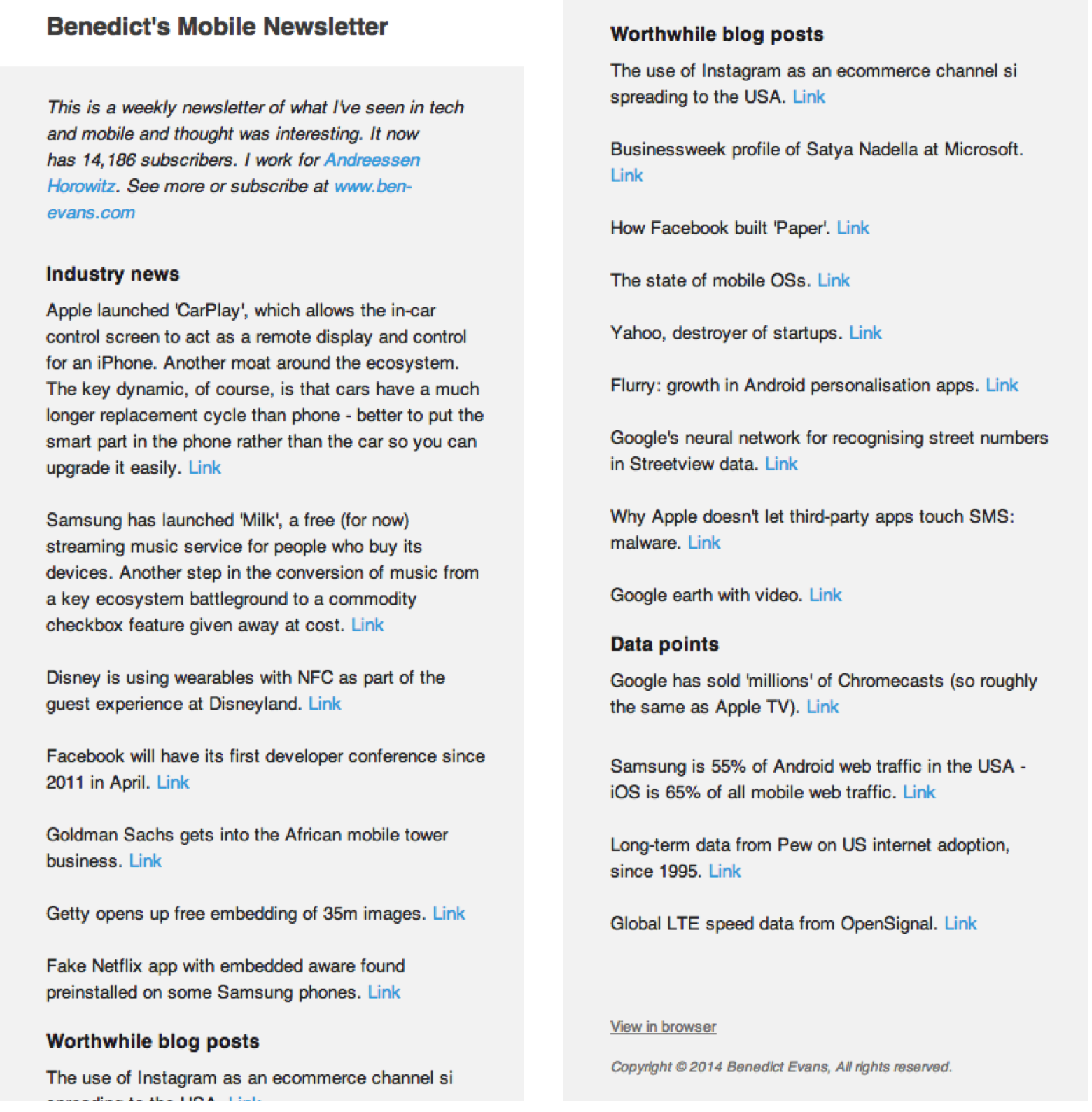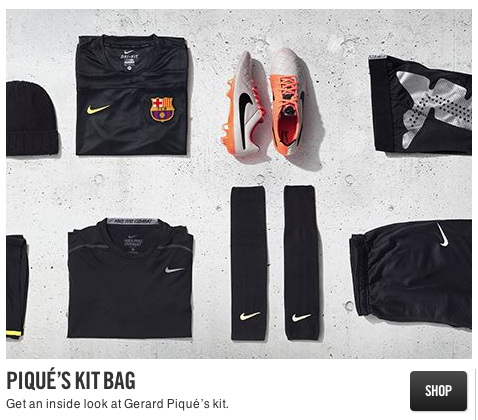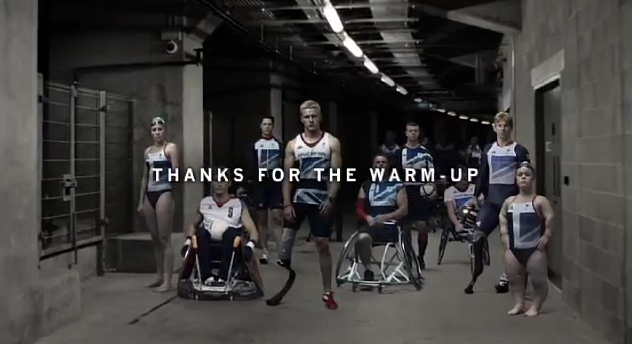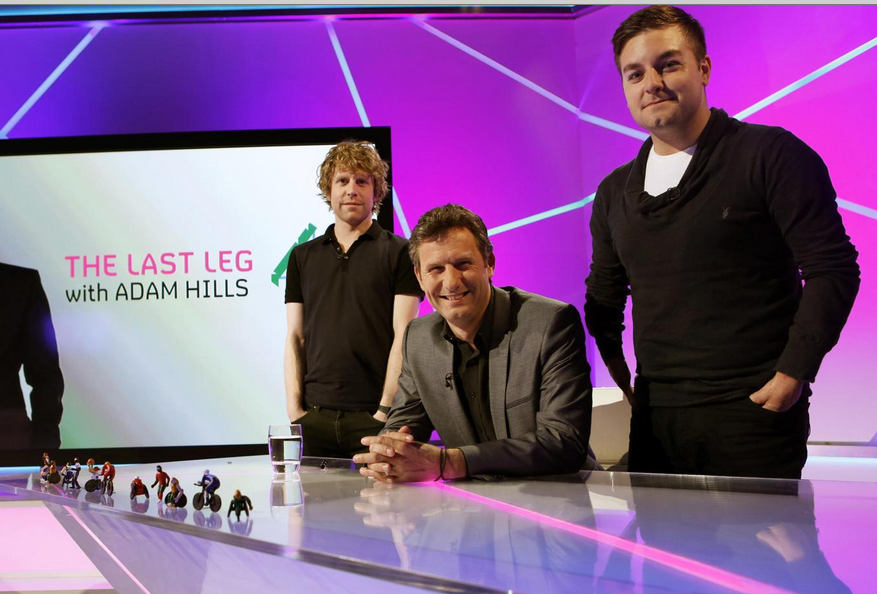go supergnova.
This is a paper written for the final assignment of the IPA's Excellence Diploma in Spring 2014. 1 You can read this on any size device, and it was last updated at 10:46 GMT on the 13 July, 2014.
It's about 7,000 words long, plus another 2,000 or so if you count the sidenotes. It takes about 10 minutes to skim, or more like half an hour if you're more thorough. It's also set up to play nicely with Instapaper, Evernote and Pocket, if that's your thing.
Hover over the little green markers for extra knowledge. One single dot means a footnote with a simple reference, which you can breeze over if you wish. 2 Three dots indicates a more detailed footnote with some supporting knowledge. 3
Thanks.
— James Borrodell Brown.
A quick summary
101 words
Our new ability to easily, instantly access the world's knowledge is a game-changer for society and brands. Knowledge is now our primary identity signal – the subjects we choose to know personally are key to who we are. The richest and most valuable kind of knowledge is anything that can't just be looked up.
Brands, however, are still pumping out junk knowledge into the world, even including stuff that can be immediately disproved. For a brand today to claim it stands for something, it must create new knowledge that consumers can't get anywhere else, and then give it away for free.
– gnostic
ADJECTIVE /ˈnɒstɪk/
Relating to knowledge, especially esoteric knowledge.
Origin: Late 16th century (as a noun): via ecclesiastical Latin from Greek gnōstikos, from gnōstos 'known' (related to gignōskein 'know').
Most brands today are what I call agnostic brands.
They don't understand the knowledge space they are in, they don't keep up with knowledge that consumers expect of them, they don't contribute any new knowledge to the world, and they make false claims about what they know and believe in. In short: they are weak brands, and they have little to offer consumers today outside of the functional, i.e. as an aide-mémoire and choice shortcut.
Some brands, however, have gone supergnova, and are finding ways to do the exact opposite. They understand what knowledge consumers want and expect of them, and are giving it away. These brands are creating and providing new knowledge that consumers can't get any other way, which helps them to understand and signal their identities. This kind of knowledge is the new value-add, the new "function-plus" that brands can help deliver, and to which customers can emotionally connect.98
“Knowledge is of two kinds.— Samuel Johnson, 1775
We know a subject ourselves, or we know where we can find information upon it.”
Smart move: the British Library have placed this quote in huge lettering right by their entrance. 4
I looked it up online, because that's easy to do these days, and it seems that Johnson uttered these words out loud on a Tuesday, in April 1775, while visiting the villa of the poet Richard Owen Cambridge. Ignoring his impressive art collection, Johnson “ran eagerly to the library, intent on poring over the backs of the books.” He didn’t want to actually read them. He was cataloguing them in his head, so he might return to them when needed. 5
I believe the most significant recent development in society is our easy, instant ability to access these catalogues and the knowledge within them. Led by the rise of personal, internet-connected devices, anyone knows where to find information upon any subject. And they can access it whenever and wherever they want.
Within the context of Johnson's quote above, with access to this ever-growing trove of information, we are approaching omniscience. We have what I call bottomless knowledge.
Anecdotally, this absolutely rings true. Consider the pub arguments we used to have about what year a film came out, or whether it won an Oscar. Just look it up, stupid! Bottomless knowledge is a tap away. “Hey Siri, what’s the capital of Honduras?” 6
This is why I’ve created a website for this assignment. Today, knowledge simply doesn’t work very well for us when it’s constrained by a piece of paper (or a single billboard poster). We explore and we look things up. We search, and browse, and follow our noses when things intrigue us. Bottomless knowledge has changed consumer behaviour - in a store, 33% of us would choose to consult a smartphone rather than talk to a store employee. 6
That’s why this assignment is full of links, and has all these sidenotes, and has imagery and videos that live in other places. It's also why I published this website before it was marked - today, we demand access to knowledge as soon as it's available. We don't care if it's been ratified yet.
Also, come on, who carries printed essays around with them? We want our knowledge at all times and contexts, and you can look at this website at work, or on your phone during a meeting. We expect knowledge to be practical, open, distributed and ready for remix and discussion. So it is here.
Access to bottomless knowledge has happened so quickly, and its consequences are so deep and diverse, that I don't think we as a society (let alone the marketing/advertising industry) have really processed it all yet. It's fluid and happening around us right this moment. 24
Although it's difficult to quantify, I believe bottomless knowledge has far-reaching effects on the nature of honesty and lies, authority, education and expertise, to name just a few. 53
Let's quickly look at how we got here.
- ⓵Protected Knowledge – the age of elitism
pre-17th Century
During this time, knowledge is grounded in tradition, faith, superstition and myth. Held tightly by authorities that fight to control its distribution, they keep power by witholding access. 7
- ⓶Scientific Knowledge – the age of enlightenment
From the 17th century
A revolution: the promotion of personal knowledge, through reason, logic, the scientific method and the search for truth. All accessible within an individual's own mind. 8
- ⓷Knowledge Society – the age of know-how
Mid-to-late 20th Century
Another breakthrough in access to knowledge, led by rapid expansion of the academic system, globalisation and technology, particularly the Internet. Our economy's key resource is no longer labour, raw material or capital - but knowledge. 9
The ability to create and disseminate knowledge is now freely available to everyone – see for example the rise of blogs, how-to shows and self-help books over this period, the increased use of the term 'knowledge society' to describe modern culture, 11 and the invention of the term 'brain drain.' 11
- ⓸Bottomless Knowledge – the age of access
Today
As the number of internet-connected personal devices on the planet rises into the billions 12, we begin to see a feedback loop. As access to knowledge becomes more of a fundamental part of our lives, so more goods and services are created to take advantage of it, thus making our access even easier, cheaper and central to our lives, thus worthy of investment from businesses, and so on. 13
I found a great new word for that in my thesaurus app: autocatalytic. 13
Access to knowledge has become a utility. And when we have the internet in our pockets, or spend time with people who do, then we have bottomless knowledge. 14
Back to that Samuel Johnson quote at the top. You can know a subject yourself, or know where to find information on it.
Knowledge is a moment away, and increasingly comes to us without asking. There is only so much time in a day. So the subjects we choose to know intimately have become key to who we are. With such a super-abundance of bottomless knowledge available, what do we choose to keep in memory, and say that we know personally?
To describe our identity is to describe what we know.
Today we experience a general pressure to be on top of knowledge, and to have perfect, up-to-date knowledge wherever possible. "Oh, didn't you know?" is a cruel and embarrassing question to endure. The urge to check our emails, to check the score, and to know what's happening is addictive and strong.
That's because if we say something is important to us, then we are expected to know about it. You say you love West Ham football club, but you didn't know the final score from a couple of minutes ago? You didn't even know that the manager changed last week? Be real. You're no fan. 87
In truth, because knowledge is bottomless, we can't even keep up to date with the things we care about. So we have found shortcuts to quickly signal that we have knowledge. The data scientists at traffic analysis firm Chartbeat found that, across the web, there is zero correlation between sharing and reading. Just because we tweeted about a news article, doesn't mean we read it properly. 82
If social media has taught us anything about ourselves as a species, it's that the human impulse to share trumps everything else. 22
With knowledge as our primary tie to identity, it's critical to keep up with it and show that you get it.
Managing our knowledge signals
There's something like three hundred billion (300,000,000,000) emails, messages and updates made, sent and read every day. 30
People growing up with this mind-boggling quantity of information, for whom knowledge is a critical identity signal, are figuring out how to control and wield it for their own purposes.
Teen facebook users have invented the practice of "super-logoff." When they're going out on a Friday night, they don't just log out, but they delete their entire account, reactivating it the following morning. Youth researcher Danah Boyd describes the strategy: they are "minimising risk when not present to address it. It's a great strategy if you're worried about people who might look and misinterpret." 83
Since knowledge is now the most informative identity signal, other people are busy trying to understand what you know about. They'll find it by looking at what you say and do, and what others have said about you too. 84 So it has become vital to keep a handle on what knowledge signals exist about you, and manage them appropriately. 72
Avoiding knowledge is a skill
For the last few years, a small group of sports fans in America have been playing a game they call "Last Man." The objective: to go as long as possible without knowing who won the Super Bowl. 26
They call it "running from the knowledge," and the best they've been able to manage is four days, two hours and forty-nine minutes. Knowledge that is culturally important seeks you out like a heat-seeking missile.
#Theknowledge was everywhere today. Amazed I survived. But tomorrow will be tough. How long can I stay off email, social media? #LastMan
— John Carney (@carney) February 4, 2014Have you been watching Game of Thrones? When the penultimate episode of the third series - the one with 'the red wedding' - was shown on British TV last year, well, let's just say there was some plot development.
I had recorded it to watch the following evening, and had avoided "the knowledge" by keeping contact with friends to a minimum. Alas, when I picked up the Metro on my commute that morning, every detail was splattered across Page 3. Ah! 64
Film critic Adam Batty calls it "a culture of spoilerphobia." When new knowledge is created, the world wants to access it, which means it's discussed, distributed and copied to multiple places. If you personally want to delay your access to knowledge - like watching a show the day after it's been aired - then "the onus and responsibility falls on you" to disconnect yourself from the world appropriately. 27 This is harder than ever in an age of context-sensitive push notifications on your smartphone. 71
How can brands add any value in a world where knowledge is bottomless and super-abundant? What kind of comms cuts-through in this kind of culture? And how can brands help people to navigate more skilfully?
For a business, a brand can provide strategic focus, 91 pull staff together, 92 give customers a reason to remember the purchase, 93 command a financial and psychological premium, 94 and create the environment for an easier purchase decision. 95
They provide the means for consumers to connect with a business emotionally, 96 and by defining a business as more than the sum of its products, a brand provides the flex to adapt their offer to the market when necessary. 97
What do brands offer consumers?
They have functional benefits: an aide-mémoire for that thing we liked once, a shortcut to purchase when we're time poor, an assistant when we don't know how to choose.
But deeper than that, brands are a way of signalling to others (and to ourselves) what it is that we stand for. Like the sports teams we support, the music we listen to, and the company we keep, our affiliation with particular brands is a way of understanding, adding to, and communicating our identity and status in the world. Brands and identity have forever been tangled up in complex ways.
So sharp brands, and us sharp brand managers, know that if our brands can't add any value to customers' identities, then we are making a critical misstep.
And yet, I believe that's exactly what has happened. Access to bottomless knowledge has changed the nature of identity signals, but our industry has not yet adapted.
Tacit knowledge is the richest signal
There are many ways of categorising knowledge. The most useful distinction is between explicit and tacit. 67
Explicit knowledge is anything that has been articulated, written down or stored somewhere.
Classic examples include assembly instructions for a bookshelf, textbooks, manuals and newspapers. Modern day examples are live stock tickers and sports scores, a photo album of a holiday, or a social media comment.
Explicit knowledge forms the vast majority of knowledge available to us at any time, and it has grown at an extraordinary rate. 90% of the world's explicit knowledge was created in just the last two years. 29
Tacit knowledge is knowledge that can't be easily communicated or obtained. It is highly personal, and very difficult to capture. 68
For example, I could read a hundred books about karate, but that wouldn't make me a sensei. I can't speak Russian by rote-learning the grammar and the vocabulary. And I can look at plenty of photos of the deep jungle, but as long as I haven't spent a week in a tent surrounded by spiders, I can't say that I truly know it.
Acquiring tacit knowledge takes time, experience, and close contact with people who already have it. It might take days, years, or even a lifetime.
In a world where explicit knowledge is super-abundant, tacit knowledge has scarcity value and is a much richer identity signal. It's the stuff that you can't just Google and look up. 70
This distinction should seriously worry us.
Our industry is in the habit of creating explicit knowledge and paying to put it in front of people. But like the invention of the photograph dealt an existential punch to the painted portrait, 66 so a world with access to bottomless knowledge, and its super-abundance, is throwing our traditional brand communications model into crisis.
Tacit knowledge is where we can help consumers to understand and signal their identities. But it cannot be transmitted via a one-off broadcast campaign.
Agnostic brands
For a brand to assert today that it stands for something, that it thinks certain matters are important, or to claim that it is associated with particular values, then it absolutely must possess and then show off the relevant knowledge. Agnostic brands are failing to fulfil this basic hygiene factor. They make false claims about the knowledge they possess, and have little to offer the world other than a quick choice shortcut.
In contrast, brands that have gone supergnova are doing the exact opposite. They are adding value to consumers' lives by creating and sharing new tacit knowledge for them to use themselves.
So here's how to actually do it. Three steps.
Step 1. Prove you get it
Step 2. Cut down on your junk knowledge
Step 3. Create new knowledge and give it away
⓵Prove you get it
To say that your business stands for something greater than your products - to even have a brand at all - now means proving you've got the knowledge.
Getting this can wrong can be fatal. A few years ago, Pepsi launched a campaign for its Amp Energy Drink, called Amp Up Before You Score. It claimed to advise men on how to pick-up 24 different "types" of women, such as "aspiring actress", and "rebound girl". Once conquered, users could add women to their "brag list," and post it to social media.
Anger and criticism followed - from men, women and college students of all types. 34 Pepsi backed down and removed the app, wasting hundreds of thousands of dollars in resource and marketing spend.
I found one smart question amongst the outrage. Here's marketing student Jack Jorg: "Pepsi have been objectifying and stereotyping women in their ads for years without causing the level of controversy this app did. Advertisers have been selling sex for decades and will continue to do so in the future...why did it cause such an uproar?" 35
The difference is that past sex-related campaigns from Pepsi - like the Dare For More campaign with Britney Spears - were agnostic. 40 They were not trying to claim that they had any knowledge. For better or worse, it was simply trying to make you associate Britney Spears' body with a can of Pepsi.
The Amp Up campaign, in contrast, claimed to know what it's like to be a male college student. Instead, they proved they had zero knowledge of the language, tone and values of their customers. It was awkward, clumsy and inappropriate. Zero knowledge = zero brand equity.
A better approach from an energy brand targeting students is Pro Plus. Their 'Stay Alert' campaign showed that they knew what it was like to be a student. They also launched a Student World website with revision planner spreadsheets, stress advice and coursework tips. 46 More recently they've launched sponsored Spotify playlists with music to get past your hangover and get on with your day. 36
(Click/tap to enlarge images)
It's what you don't say
Sometimes proving that you've got the knowledge is less about what you say, and more about what you leave out. Danish science writer Tor Nørretranders invented the term "exformation" to describe the idea.
37
Unlike information, exformation is the stuff you leave out. Sometimes just a few words carry an enormous amount of knowledge. This keeps communication succinct, but it also creates a personal connection. It's like having a private joke.
Here's an example below. By choosing this image, and all its exformation, I'm showing off my knowledge of funny tumblrs, the realities of agency life, what the acronym PTO means, animated animal gifs, and what it's really like to be on annual leave while you write a diploma assignment. 41



Many forms of cryptography work to a similar principle. Both the sender and receiver possess a public key, which can be accessed by anyone and is used to turn the initial message into a coded one. But they each also have a secret key. Only when these keys have been combined can the message be decoded and understood. 38
For brands, this means understanding the language and knowledge space of your consumers (acquiring the public key) and then using communications that shows that you get it (creating a secret key).
Below is a great example from Budweiser. When they first began sponsoring the Premier League - the first ever American brand to do so - they ran this ad, claiming to have no expertise with football, and acknowledging that they could not possibly have acquired true tacit knowledge about football in their short time as sponsors. But in doing so, they actually proved they had the knowledge. Slick.
Last month Budweiser announced they were ending their UK football deal, which has paved the way for bigger things. They are sponsoring the Fifa World Cup in 2014, 2018 and 2022. 39
And here's Thomson's recent campaign, proving that they get what holidays mean to families. The hugely positive consumer reaction is shown in the gallery below. 69
It was accompanied by a website that continued to show they understood the realities of working life for fathers (the primary audience target). It also include a stress test, to examine your mood and need for a rest.
This could have easily been a throwaway feature, but Thomson continued to demonstrate that they really did have the relevant knowledge about psychology and anxiety: it included several Rorschach tests, a language-mapping exercise and a sophisticated model based on colour theory.
Agnostic brands still think they know best, and are trying to set the agenda by forcing their messages in front of consumers. 55 To go supergnova and prove you get it, we must turn this on its head. Start with the customers who really care about your category, find out what knowledge these people want, and let customers set the agenda. 85
Nordstrom, the US department store, took an early interest in Pinterest as a form of trend-spotting. They now display their "most-pinned" items in stores, and have begun rolling this out more widely to create the world's largest wish-list. Sales advisors on the floor use a management app that matches popular Pinterest items with Nordstrom products. It shows customers that Nordstrom is keeping up with the latest knowledge - as consumers we expect nothing less - and that they are genuinely using it to inform their products and services. 57
⓶Cut down on your junk knowledge
One of the oldest and most abused tropes in TV and film is that of infinite ammo.
Our hero always seems to have a bottomless supply, although they may run out just before reaching the boss (perhaps with just one bullet left). Reloading only exists for added suspense. 42
As marketers, it's easy to think that we also have infinite ammo. As the third IPA Datamine report put it: "There are few hotter topics in marketing these days than how to make best use of all the communications channels available to us." 43
With an increased number of consumer touchpoints, well-orchestrated multi-channel campaigns do have better cut-through and effectiveness (on the whole) than single-channel ones. But it's misleading to conclude that we must therefore pick up the machine gun and hold down the trigger.
Indeed, I believe much of our communications to consumers is giving them what I call junk knowledge. Just as it's possible to add sugar, caffeine and fizz to a glass of water, so the same can be done to knowledge.
Witness the meteoric rise of news magazines like Buzzfeed and Upworthy, who have found ways to sprinkle sugar on the light knowledge that they're giving away: turning articles into top 10 lists, photo galleries, or animated gifs, and using competitively emotive headlines. It's a copywriting arms race. "9 Out Of 10 Americans Are Completely Wrong About This Mind-Blowing Fact." "Baby Polar Bear's Feeder Dies." And so on.
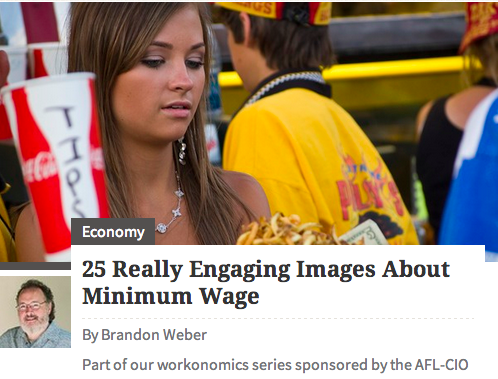
(Upworthy.com)
But it's a very short-term hit. You read it, and you're onto the next. It only works because they're publishing hundreds of articles a day.
Songwriter John Roderick puts it nicely. “As a culture, we’re satisfied with worse, because there’s so much more of everything. Nowadays, with everything we do, we’re just flipping through index cards.” 98
This is a warning sign for our industry. Many of our techniques for achieving cut-through (ramp up the emotion, the weirdness, the number of channels used, etc) are based around conceits, exaggerations, or outright lies. Junk knowledge is so prevalent that people have started to create plausible adverts made entirely out of stock footage. 78
We need to cut down on our junk knowledge and remember that we have limited ammo. We're focussing on recall, but a better, longer-term goal is to focus on creating and sharing quality knowledge.
Take email newsletters. 78% of the marketing/advertising emails we send as an industry aren't even opened. Straight in the trash. 44
One simple reason is that they lack focus, and fire too many bullets. Flick through the gallery below and you'll see what I mean. "Surely one of these boxes will interest customers?"86
Compare and contrast with the newsletters from mobile agency Addictive, and strategy consultant Ben Evans. The former writes a huge 2,000 word email essay every week - even longer than the examples above. But as an expert summary targeted to a small audience, it's jam-packed with knowledge. Ben sends an analysis of what he's seen this week and his view on what it means. High quality knowledge: they get 70-80% open rates. 45
Imagine British Airways writing regularly about what it's like to be a pilot, an engineer, a frequent flyer, or be so dedicated to customer service. Only then, breaking out of the schedule, in a different design and tone, can they reasonably ask for something in return. Here's one of our offers, personalised to what we saw you liked. Choose us for your next flight.
Debunking is easy, so stop making false claims
Consider the runaway success of near-live fact-checking services like FactCheck.org, an independently-funded group that monitors the factual accuracy of what's said by U.S. political players.
90
Now consider the impact of this on brands who are making untrue or exaggerated claims about themselves.
In Mandarin, there is a character - 得 - that is used especially for comparisons based on a conceit or an unnecessary embellishment, as in the sentence 'It's sooo good, you'd be crazy not to buy it.' If this character existed in English, you'd see it in much of our advertising - like the below from Pom and Altoids.
If customers can debunk any of our claims at any time, doesn't that make us look a bit stupid and vain for trying to win them over in this way?
Agnostic brands, seemingly unaware of this problem, are ploughing ahead regardless. See the Grey Goose example below - which of this is true? Of course there weren't actually any riots. Isn't Grey Goose run by an American billionaire? If the barman is an actor, is that the real Francoise or an actor too? After this mix-up, the claim that it is "the world's best tasting vodka" surely falls on deaf ears. 54
Know when you're full
It's easy to tell when we've run out of money, time, or space on a poster. But like junk food, it's very difficult to figure out when we're full up with knowledge.
A few years ago, in an award-winning experiment, Prof. Brian Wansink sat people down with a tasty bowl of soup, and asked them to eat until they felt full. For a select group of subjects, however, his team had drilled holes into the bottom of the tables, pressure-feeding soup into the bowls, effectively making them bottomless bowls of soup. On average, these people ate 78% more. 60
Wansink calls it "mindless eating," and to change it requires putting in place physical constraints and visual cues, like switching to smaller plates and silverware. 61
We could do the same, to cut down on the junk knowledge that we're broadcasting. As the saying goes, you can't change what you don't measure. So let's try creating a running tally of every message we're sending out to consumers. Every tweet, every email, every banner ad, every TV spot and press advertorial. Post it to the wall for everyone on the team to see, and make it visible to everyone who's working with the brand.
Similarly, in our consumer research we should ask potential customers about their knowledge habits. What's overwhelming? What feels like junk to them? At what times and in what contexts are they keen to learn, and what do they wish they knew more about?
⓷Create new knowledge and give it away
The Evening Standard used to feature headlines like "Cabinet Minister Resigns." You had to buy the paper to find out what had happened. Here's what went on today while you were at work: a brilliant editorial strategy. But today, it's absurd to think that you wouldn't already have that knowledge by the time you reached the station entrance.
When the horsemeat scandal broke, all the supermarkets scrambled to get ahead of the news, apologising in one breath, then claiming to be the most transparent in the next. Tesco probably did the best, and are still regularly publishing their DNA results. 19
But in those first few days, as facts, rumours, gossip and scandal all swirled around together, knowledge was changing second by second. Every moment that they spent preparing for a press conference, they were losing brand equity.
It's difficult for a brand to lead when knowledge is changing in real-time. When the context and culture is shifting constantly, how can we build up a clear picture or an association in consumers' minds?
In the age of the ephemeral, things that last stand out. While still keeping up with the latest knowledge in their particular area, brands going supergnova are finding appropriate subjects where they can go deep, like investigative journalists. 59 We can look to innovative publishers for best practice here - part of a great newspaper’s value is in slowing down when everything else is speeding up. 56
Let's imagine how this might work for Tesco Food. While absolutely keeping up with all the latest knowledge relevant to them (think recipes, health food, discussing whether Jaffa Cake is a biscuit or a cake 58) they could "go deep" on food provenance, or food science, or food logistics, and give away knowledge that only Tesco could create. It looks like their Eat Happy project is well on the way to achieving this, with teaching toolkits, virtual classrooms and knowledge about how food gets to the shelves.
"We know more than we can tell"– Scientist and philospher Polányi Mihály, 1958 31
Polányi was something of a polymath. In between his work on x-ray diffraction and atomic reactions, he invented the concept of tacit knowledge and became a prominent philosopher. He argued that tacit knowledge was intimately personal and stuck in our heads. It's knowledge that we know we have, but struggle to describe - like catching a ball, or picking out a rug that pulls a room together.
Tacit knowledge should be a fascinating concept to the communications industry. We spend our working lives working out the best ways to convey indistinct information. No doubt some of the brands we work on have been building up tacit knowledge for generations. Unlocking and revealing those secrets is genuinely my favourite part of brand marketing.
But we hit a problem right away. A defining feature of tacit knowledge is that it cannot be comprehensively articulated. How can it be transmitted at all?
Craftsmen and women regularly deal with this problem, as veteran workers are required to pass on their skills. Factories often attempt to do this by trying to write it down, or filming a mechanical replication. But this always seems to lose its "feel" - a simulation just isn't good enough. 88
Academics, philosophers, management consultants, teachers and HR specialists have spent considerable time working on this puzzle. Here follows five different techniques, Ⓐ to Ⓔ, with suggestions for applying it to our discipline.
Ⓐ A close interaction over time
Transmitting tacit knowledge requires the close involvement and cooperation of the two subjects involved, over an extended period of time.
73
For example, to truly say you know Berlin, New York or Tokyo, you really need to live there, or stay over with someone who does.
Airbnb have captured this brilliantly with their recent campaign aimed at Londoners who crave that knowledge. As an Airbnb customer, you get to stay in a real Berlin house, and meet a real Berliner. By being so close to the real thing for a whole weekend, they are saying, that tacit knowledge is going to filter into your brain by osmosis.



FMCG brands, despite typically being purchased and used without too much thinking, are actually well-placed to use this technique. Think how many hours you spend with Colgate or Kellogg's every day, over many years. Imagine a campaign about the knowledge that you can only get by sitting round the breakfast table, however briefly, with your family every morning. Those fools who get a snack bar on the run are missing out.
Ⓑ Build up a shared understanding
When a subject is so complex and thorny that talking about it seems impossible, teachers, diplomats, negotiators and lawyers begin by agreeing some basic terms of reference.
74
I know I'm not meant to use Dove Real Beauty as an example in a marketing paper, but... I believe one of the unexplored reasons for its success is that it provided a new language for all of us in society to talk about feminism and the female body in culture.
In its own little way, it articulated something that a huge number of us had felt, but weren't sure how to express. It gave us a way to signal our knowledge.
A number of other 'classic' adverts, which have become cultural touchstones, have also succeeded by putting words to our feelings. Below is the multi-award winning Budweiser spot from 1999, and its follow-up (from the Director, not Anheuser-Busch) a full nine years later.
Rather than trying to find a quick bit of added reach in earned and shared media, we should be measuring our performance by the extent to which the language of our marketing becomes long-term vernacular.
Ⓒ Come at it from a dozen angles
To impress somebody who already thinks they're an expert, you have to surprise them. Connoisseurs are promiscuous, and want different forms of gratification at different times.
75
To engage someone who already believes they have tacit knowledge, we need to really up our game and go to the edge in a myriad of ways.
89
Paddy Power are the archetypical example of this. With their wry, ironic, knowing tone of voice, they have applied their trademark wit to every single opportunity that comes their way.
During the horsemeat scandal, for example, they didn't skip a beat. Announcing that customers could now bet on which animal contamination would be found next, they then said: “Talk about product innovation; not only can you back horses with Paddy Power but now you can also eat them. This is something our punters can really sink their teeth into.” 76 They then took to the streets of Dublin to give away free burgers during lunch.
Ⓓ Design an apprenticeship
Polányi speaks highly of apprenticeships and mentoring. "By watching the master, and making efforts in the presence of his example, the apprentice picks up the rules of the art."
77
Whether they realised it or not, Nike Football have created an apprenticeship scheme for us to learn from the masters.
They show us what the dream is like, what the masters do, what their incredible life is like. It's the kind of tacit knowledge that we can never attain, but Nike Football gives us a glimpse.
In 2009, they created the Nike Football Academy - a real-life, pro-level training programe that helps unsigned under-20 players find a club, organised by Nike. Who else could get Mourinho, Rooney and Ronaldo to pop over and coach for a weekend?
Their online shop follows this model right the way through to purchase. Not sure what to buy? Well have a look through a Barcelona player's kit bag, or what the pro players use just for their boring, everyday training.
Ⓔ Ex novo: build it from scratch
Sometimes there's a business opportunity that means having to educate consumers - here's something you didn't even realise you could know about. New knowledge can be captivating, and "transforms the entire slate of the knower's mind."
78
We can learn from inventive broadcasters, who have helped set the bar in this area.
Classic FM, for example, has spent twenty-two years teaching a generation the tacit knowledge of classical music. Reading a book about classical music only gets you so far, and they have found success by framing it as a relaxing hobby. 79
Channel 4's brilliant Paralympics teaser campaign, "Thanks For The Warm Up", accompanied their moving superheroes spot. They followed it up with a round-up show called "The Last Leg", featuring chat and stand-up from a one-legged man. It regularly pulled in over a million viewers each night of the games, and is now in its fourth series. 80
This witty, self-deprecating take on disabilities gives viewers the knowledge and confidence to talk about inclusiveness, resilience and sport in a new way. Channel 4's willingness to trailblaze has improved our society, and has been rightly praised for its commitment to communicating this complex tacit knowledge. 81
Let's create a new job position to get this going: a knowledge strategist. Sensitive to both traditional brand performance and cultural understanding, they can help brands lead in a world of bottomless knowledge.
Here's a job advertisement for you to use.
(Download as docx | Download as pdf)
Senior Knowledge Planner
Role Profile
As senior knowledge planner you will oversee the brand and communications strategy for one of the UK's leading brands, as we help them to go supergnova.
Working closely with our research, creative and editorial teams, over 3-5 years you will guide this brand to a category-leading position.
By discovering what this brand should care about, and uncovering the relevant knowledge spaces that it must understand and keep up with, you will work out how to show customers that this brand "gets it."
And by discovering where this brand can be an expert, you will help them create and lead new knowledge spaces, and ensure that the team create brilliant communications that customers want to learn from.Skills Required
- Training in a human-centred social science eg sociology, anthropology, psychology, cultural studies, linguistics, etc - what knowledge do our customers want, and how do they signal it?
- Expert using social, semiotic and data tools/analysis to uncover and describe knowledge spaces - what explicit knowledge must our brand keep up with, and where is there too much junk knowledge?
- Ability to conduct or commission qualitative and quantitative studies, both with consumers but also with our clients - what tacit knowledge do we already have? And what tacit knowledge should we be learning?
- At least 5 year’s strategy/planning experience in brand communications across multiple channels - how do we communicate our knowledge to consumers, and give it away so they can use it?
- Innovative business thinker - where can our brand lead and how will it affect profits and shareholder value?
Often all it takes is some new documentation to change the way an agency behaves. So here's a new way of thinking about the creative brief: the knowledge brief.
(Download as docx | Download as pdf)
As an example, I've filled it in using a category which hasn't done any brand communications work for over a decade: house-builders like Persimmon Homes, Taylor Wimpey and Barratt.
Creative / Knowledge Brief
What knowledge does our audience want and why?
For no other high-value product are consumers expected to spend so much but know so little. Often they are expected to buy before the house and neighbourhood has been built. Our customers want to know how to buy a house without getting cheated. And they want to know how to turn a house into a home.
How/where will they be signalling this knowledge?
- To friends, pre-purchase: via messaging/social media, usually photography
- To friends, post-purchase: at a housewarming.
- To family: tagging along to showroom visits / come round for cup of tea
- To others: advice-giving / tip-sharing
What explicit knowledge do they expect of us?
Materials and engineering (e.g. brickwork), design and aesthetics (e.g. interior design), project management (e.g. building on time), finance (e.g. mortgages), local amenities (e.g. supermarkets).
With so much junk knowledge, how can we be expert?
Everyone in the property market, especially estate agents, talks in a special coded language - "charming tidy bijou, boasts a family bathroom." We could be experts in converting these buzzwords into plain English, and gain their trust by making things clear.
Who else is giving away knowledge? (our competitors)
- Broadsheet Home supplements: area guides and cheat sheets
- Aggregators e.g. RightMove: customer reviews, house prices, local schools
- Friends and family: previous experiences, practical tips
- Banks, lenders, government: financial advice, buying schemes
- Estate agents: local area guides, competitive landscape
- Blogs, forums, social media: design inspiration, how-to guides
What tacit knowledge do we have, to give away?
Many of our staff live in nearby neighbourhoods and know the locals. We know the best pubs, the best running circuits, the best place to walk the dog, what it's like on a Friday evening and a Tuesday afternoon. We've got a feel of the place that you can't get by reading about it in a brochure or looking it up on the internet.
Some first ideas that come from this brief
☆ Use local slang wherever possible
☆ Video diaries from customers moving in and making it their home
☆ Local interviews - the butcher, the teacher, the pub landlord
☆ Live Q&A sessions with finance/design experts on social media
☆ A style manual for using plain English + avoiding buzzwords
☆ Walking/cycling routes and tours from our staff
☆ Stay the night in a showroom, we'll provide breakfast
☆ Fifty simultaneous housewarmings across the country
How did you feel about all those green sidenote bubbles? Did you read them all? I imagine they began to grate after a while.
My data says that the average reader here is tapping on 46% of the one-dot notes and 63% of the longer three-dot ones.
That makes sense: today we presume that we can take and skip knowledge as we wish. We explore it in a self-directed, conscious way. Junk knowledge, presented in the wrong context, is now completely ignored. You, as the reader, get to make the decision, and it's up to me to persuade you that the knowledge is valuable.
Brands help us to see, feel, know and signal our place in the world. This hasn't changed. But access to bottomless knowledge has changed the nature and content of these signals, and as brand managers we must adapt.
There's a small company in Worcester called BeerBods, who for a small subscription fee will send you twelve beers in the post every twelve weeks. It's not like the Wine Society, though. Everyone drinks one beer a week – the same beer, often at exactly the same time on the same night – as the story behind the beer is revealed. It has quickly turned into a remarkable community of (mostly) blokes, chatting online about the beer and whatever else comes to mind.
The whole concept is based on a brilliant insight. These 30-year-old-ish guys are settling down, aren't going out to the pub with their mates as much, and are losing their knowledge about beer and the latest banter.
Wait. Actually, it's much more than that. They worry they are losing knowledge about being a man.
And this brand is helping them to get it back, and to grow it anew. It's guiding them to the kind of knowledge that's profoundly personal to their lives, and giving them ways to signal it. Today that kind of brand behaviour has a deep power to it. That's what it means to go supergnova.
-
That's the Institute of Practitioners in Advertising, who are the professional body for advertising, media and marketing communications agencies in the UK.
The Excellence Diploma was created in 2005 as the pinnacle IPA qualification aimed at people like me who are fascinated by brands. Candidates work through the most comprehensive reading list ever compiled on brands over a 12 month period, contribute to group workshops led by module editors and are encouraged to voice their opinion through a series of essays.
The whole thing culminates in a final thesis marked by a panel of senior practitioners and industry gurus - what you're reading right now is that final thesis for one of the 2013/2014 candidates.
-
Like for if you're referencing this paper: "I Believe Brands Should Go Supergnova," last modified July 13, 2014, gosupergnova.com.
-
Footnotes on the web are a real pain - you click on a tiny number, get transported to the bottom of the page, find the one you were looking for, and now you've got to get back and find your place. I'm using a script called bigfootjs, written by a student in Ottawa called Chris Suave, which I've edited to work here.
-
This is what it looks like, courtesy of a Mr Rob Briton, a longtime traveller from Washington DC who visited London in March 2012.
-
This is according to the book The Life of Samuel Johnson, by James Boswell, who was also there on that Tuesday with them. Fittingly, all of the knowledge contained in his book is now available to the world for free, thanks to Project Gutenberg, the world's first and largest single collection of free ebooks. (Boswell, James. The Life of Samuel Johnson. Wordsworth Editions, 2008).
-
This has now reached the point that if you ask the world a knowledge question, it will roll its eyes and look at you with disdain. See for example UseTheFuckingGoogle.com.
-
How Mobile Is Transforming the Shopping Experience in Stores, Think With Google, May 2013.
-
Dupré, Louis K. The enlightenment and the intellectual foundations of modern culture. Yale University Press, 2004.
-
Again, see Dupre, Louis. The Enlightenment & the Intellectual Foundations of Modern Culture, 2004 for an overview. There's also Immanuel Kant's essay from 1784, What Is Enlightenment, which you can read for free (and translated into English) courtesy of the University of Columbia. It contains his stirring motto "Sapere aude!", which means "Dare to know!" (Kant, Immanuel. An answer to the question:'What is enlightenment?'. Penguin UK, 2013).
-
In December 1995, Peter Drucker wrote a brilliant piece in The Alantic Monthly called The Age of Social Transformation, arguing that knowledge inequality is a more significant geopolitical issue than economic inequality.
-
From Google Ngram Viewer, showing how the phrase "knowledge society" has appeared in the titles of English books since 1860, rising sharply in the 1990s.

-
The drain of East Germany's young population to the West potentially cost it over 22.5 billion marks in lost educational investment. In August 1961, they created a wall to stop it. (Volker Rolf Berghahn, Modern Germany: Society, Economy and Politics in the Twentieth Century, p. 227. Cambridge University Press, 1987).
-
Analyst Ben Evans has been charting this with data from Apple, Google and IDC - his conservative estimate is that there are about three billion smartphones, hundreds of millions of tablets, 900 million personal computers, and we are soon to see an explosion in wearables and other internet-connected devices.
-
This year's Edge Annual Question, posed to 175 intellectuals and thinkers around the world, noted that "the biggest change in our lifetimes is the rate of change."
-
I can recommend Terminology 3 for iOS for fast access to word-knowledge. If you need convincing, the internet has you covered. Here's a 1,200 word essay reviewing and comparing the world's top thesaurus apps.
-
It's fascinating and disturbing to watch American technologists tear their hair out as national telecoms/infrastructure companies steamroller incompetent regulators, announcing plans to close and control the internet through additional fees, pay-to-play schemes and paid peering arrangements. The Net Neutrality debate is an important one - for a great explainer read Nilay Patel's barnstorming piece "The Internet Is Fucked (but we can fix it)"
-
See Tesco PLC: Our latest supply chain news and authenticity test results
-
Why You Should Embrace Surveillance, Not Fight It, wired.com, March 10, 2014
-
See for example the continuing public dismay and disbelief amid the NSA/GCHQ revelations from Edward Snowden - the impact of bottomless knowledge on privacy is a subject for a whole other essay. Just last week, a Dutch student decided to sell all his personal data to the highest bidder.
-
They've been chronicling the whole thing online since 2011. Here's the liveblogs from 2011, 2012, 2013 and 2014.
-
Was Metro right to reveal the ending of the Red Wedding episode of Game of Thrones?, metro.co.uk, published June 2013
-
SINTEF. Big Data, for better or worse: 90% of world's data generated over last two years, ScienceDaily, 22 May 2013
-
Obviously it's really hard to say exactly, and this is my own estimate. Market research firm The Radicati Group do an annual email statistics report which looks reliable, the International Telecoms Union has an overview of global SMS numbers and after their purchase by Facebook, WhatsApp founder/CEO Jan Koum had plenty of figures to give away.
-
Polanyi, Michael (1966), The Tacit Dimension, University of Chicago Press: Chicago, 4.
-
Drink's iPhone 'App' Gets Anger Flowing Wall Street Journal, October 14, 2009.
-
Digital Fail JackJorg.com. September 5, 2013.
-
Case Study: Pro Plus and Spotify, The Marketer, 2013.
-
Nørretranders, Tor. The user illusion: Cutting consciousness down to size. Viking, 1991.
-
Christof Paar, Jan Pelzl, "Introduction to Public-Key Cryptography", Chapter 6 of "Understanding Cryptography, A Textbook for Students and Practitioners". Springer, 2009.
-
Budweiser ends FA Cup sponsorship after three years, BBC News. February 7, 2014.
-
If you can't remember what the grossly sexist work looked like, you can always Google it.
-
Of course this is from the fabulous This Advertising Life tumblr blog.
This is from TvTropes.org, the wikipedia of TV/film clichés. They describe this gunplay trope as having "bottomless magazines," which inspired my description of society today having bottomless knowledge.
Datamine 3: New Models of Marketing Effectiveness. IPA, June 2013.
Global Email Marketing Benchmarks, Mailchimp.com, 2014. These low open rates are even more damning when you consider that most mobile 'opens' are actually just the phone downloading the email, not consumers actually reading them.
Ben published the figures on his Twitter account. Not sure how to officially reference that in the proper Chicago style - they don't mention it in their official citation guide.
Pro Plus Student World, ProPlus.co.uk, 2014.
More than that, I believe it deeply changes our understanding of privacy, copyright and intellectual property, politics, activism and democracy, censorship, sabotage and security, sharing and collaboration, decision-making and more.
A couple of good articles on the real Grey Goose story:
Seth Stevenson's The Cocktail Creationist". New York Magazine, 2004.
And Sidney Frank's interview in Inc "How I Did It: Sidney Frank, founder, Sidney Frank Importing". Inc. Magazine, September 2005Seth Godin on What Marketers Are Getting Wrong, Abigail Tracy, Inc Magazine, March 2014.
See for example the phenomenal success of magazines like The Wirecutter, The Sweethome, Aeon and De Correspondent, who take the time to make one single expert recommendation only, or give me a weekly briefing that just tells me what I need to know.
The Strength of Weak Signals, McKinsey Quarterly, February 2014.
See also Nordstrom touts merchandise with Pinterest, Women’s Wear Daily, July 2, 2013.Tesco's Twitter feed is a great example of showing off their knowledge of daily grind of food shopping. Their official little bio reads: "Unidentified hashtag in the bagging area."
Wikipedia's page on The Slow Movement has an extensive list of cultural subjects that are trying to bring back some reflection and thoughtfulness. They include Slow Art, The Slow Church, Slow Counseling, Slow Education, Slow Fashion, Slow Food (which some argue is where the trend began), Slow Gardening (!) Slow Goods, Slow Media, Slow Money, Slow Parenting, Slow Photography, Slow Science, Slow Technology and Slow Travel.
Wansink, Brian, James E. Painter, and Jill North. "Bottomless Bowls: Why Visual Cues of Portion Size May Influence Intake." Obesity research 13, no. 1 (2005): 93-100.
Wansink, Brian. Mindless eating: Why we eat more than we think. Random House LLC, 2007.
A little ironic, I know, given that I'm rallying against paper as an effective medium for bottomless knowledge. Metro has been impressively agile as a newspaper, finding ways like this to join the conversation the morning after.
Two Paths For The Novel, Zadie Smith, The New York Review of Books, November 2008.
Saint-Onge, Hubert. "Tacit knowledge the key to the strategic alignment of intellectual capital." Strategy & Leadership 24.2 (1996): 10-16.
Polanyi, M, (1958) Personal Knowledge: Towards a Post-Critical Philosophy. University of Chicago Press.
In fairness I should mention there were also some comments about how this treated disfigurement unfairly, but they were swamped by the more positive ones.
Some modern pub quizzes are embracing the pleasure of showing off tacit knowledge. "Let's see you try and Google this one!" they exclaim. Guess the crisp flavour, recognise a pop song from the first five seconds, and who's this celebrity couple made out of lego? Getting one of these questions right is far more satisfying than knowing what two colours are on the Polish flag.
Siri, Google Now and the recently-announced Android Wear are all examples of trying to anticipate your knowledge needs, and get it to you before you realise you wanted it.
Which, by the way, doesn't mean just trying to delete them all. Otherwise you might invoke "The Streisand Effect" - where an attempt to destroy knowledge has the unintended consequence of publicizing the information more widely. A recent example: Turkey banning Twitter has only served to make Twitter more powerful than ever.
Von Krogh, Georg, Kazuo Ichijo, and Ikujiro Nonaka. Enabling knowledge creation: How to unlock the mystery of tacit knowledge and release the power of innovation. Oxford university press, 2000.
Eraut, Michael. "Non‐formal learning and tacit knowledge in professional work." British Journal of Educational Psychology 70.1 (2000): 113-136.
Tom McCarthy, Zadie Smith, and the 'Paths' of the Novel, George Ovitt, December 2012.
Paddy Power unveils new bet on ‘next to contaminate beef burgers’: squirrel, zebra and bigfoot make the list, The Drum, 16 January, 2013.
Polanyi, Michael. 2002 [1958]. Personal Knowledge: Towards a Post-Critical Philosophy. London: Routledge.
Everything You Hate About Advertising in One Fake Video That's Almost Too Real, AdWeek, March 25, 2014
Kierkegaard, Søren. Søren Kierkegaard's Journals and Papers: Autobiographical, 1848-1855. Vol. 6. Indiana University Press, 1978.
See for example their best-selling album series, 50 Bathtime Classics ("The perfect music for a relaxing night in"), 50 Classics for Bedtime ("All you need to soothe you to sleep at night"), and 50 Classics for Babies ("50 calming pieces of music to lull your baby to sleep, peacefully").
Now C4 head for Hills, Leigh Holmwood, The Sun. 11 September, 2012.
Language, laughter and Paralympics, Gary Nunn, The Guardian. 6 September, 2012.
Why You Won't Finish This Article, Slate.com, June 2013.
Risk Reduction Strategies on Facebook, Danah Boyd, Apophenia. 8 November, 2010.
There are scores of implicit knowledge signals that brands communicate, knowingly or otherwise, such as their price, tone of voice, packaging and design, staff attitude, general body language, and the unusual occasions when they make sacrifices, show off or go the extra mile. For more on this read the winner of the 2013 IPA excellence diploma, Peter Buckley's Exploiting The Implicit.
95% of CMO's heading successful companies say that "getting closer to their customers" is their top priority for the next five year. Right now, about 80% of them study markets rather than individuals. (From Stretched to Strengthened, IBM Global Chief Marketing Study, 2012.
Email Newsletters Too Long, Too Frequent, Nielsen Norman Group, 5th Edition.
In a recent interview, Google co-founder and CEO Larry Page noted that he believes Google is only "at the very beginning" of understanding and providing for our knowledge needs. He describes the current status as "clunky and lacking context." As Google and others continue to improve their service, and our ability to find relevant knowledge gets easier and quicker, so the expectation on us that we possess appropriate knowledge will become more acute. Where's Google Going Next?, TED.com, March 2014.
"Now, what I want is Facts. Teach these boys and girls nothing but Facts. Facts alone are wanted in life. Plant nothing else, and root out everything else."
That's the awful schoolteacher Mr. Gradgrind, in the opening passage from Hard Times by Charles Dickens. By ignoring the wonder of tacit knowledge and depriving them of feeling, he treats them as machines.
Dickens, Charles. Hard times. Broadview Press, 1996.Hedesstrom, Ted, and Edgar A. Whitley. "What is Meant by Tacit Knowledge? Towards a Better Understanding of the Shape of Actions." ECIS. 2000.
There's also Channel 4's Fact Check blog, the UK-based independent FullFact.org, the Pulitzer Prize winning Politifact, and the ever-handy Snopes.com, which covers urban legends and internet rumours.
Baskin, Merry, and Mark Earls. Brand new brand thinking: brought to life by 11 experts who do. Kogan Page, 2002.
Ind, Nicholas. "Inside out: How employees build value." The Journal of Brand Management 10, no. 6 (2003): 393-402.
Franzen, Giep, and Margot Bouwman. The mental world of brands: Mind, memory and brand success. World Advertising Research Centre, 2001.
Miller, Jon, and David Muir. The business of brands. Wiley.com, 2005.
IPA. Behavioural Economics - Let's get practical. London: IPA, 2005.
Heath, Robert. The Hidden Power of Advertising: How Low Involvement Processing Influences the Ways We Choose Brands. Oxford: Admap Publications, 2001.
De Chernatony, L., and MHB. McDonald. Creating Powerful Brands. Oxford: Butterworth-Heinemann, 1992.
King, Stephen. What is a brand? London: JWT, 1971.
Primary Source Material, an Interview with John Roderick, CMD+Space Podcast, January 2, 2014.

